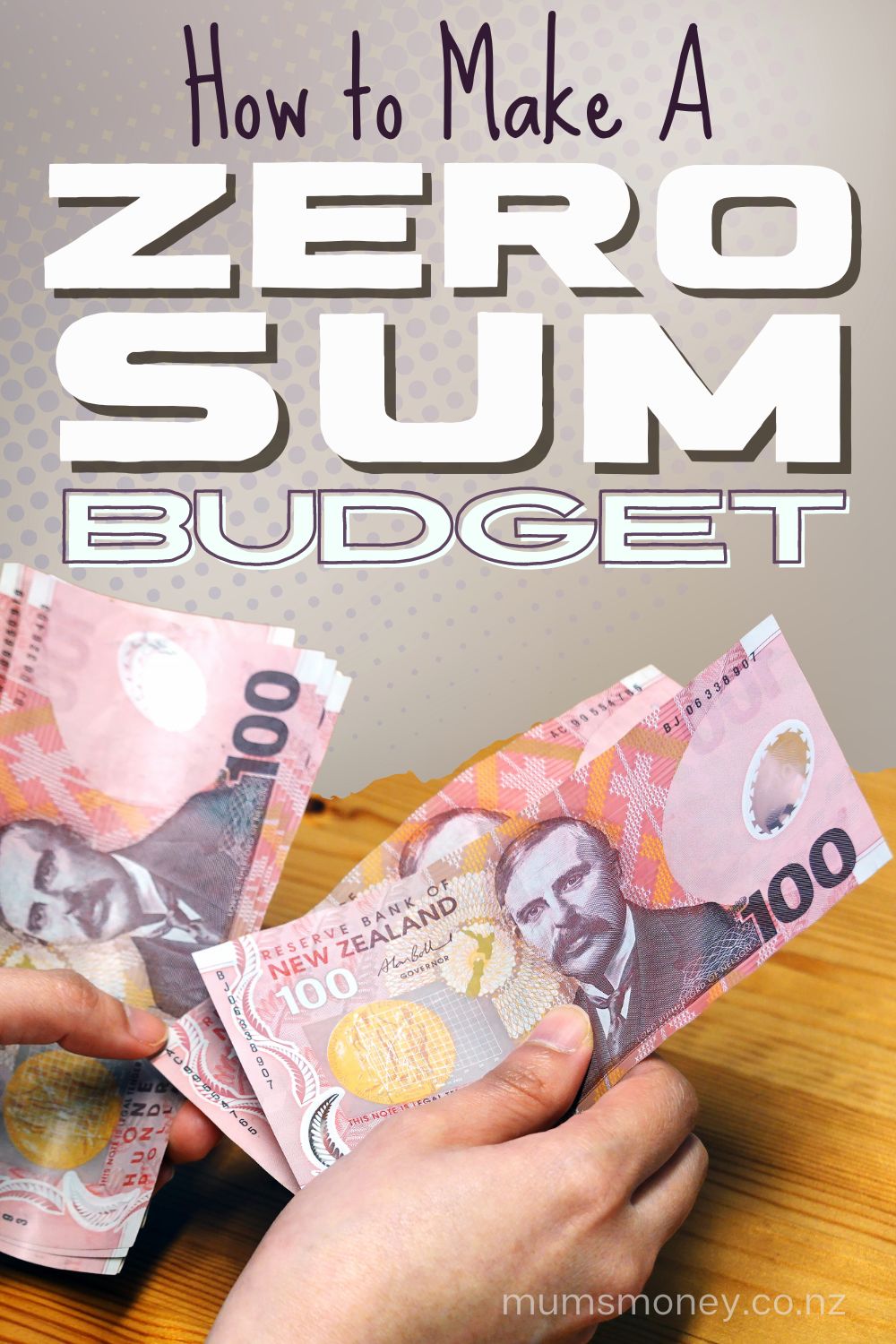Starting a family budget can be tough, especially if your income is reduced or stretched.
In times like these, a zero-sum budget can make your money work hardest for you.

What is a Zero-Sum Budget?
Table of Contents
The strategy behind a zero-sum budget is to “give every dollar a job.”
This way, you can harness the full power of your income and put your money to work for you.
It works by using your actual income to plan and pay for all of your expenses down to the last cent.
Through zero-sum budgeting, you can confidently manage your spending because you know exactly how much money you have to work with.
When creating a zero-sum budget, your expenses must match your income.
If you make $3,000 this month, you need to find a way to spend all of that money on paper before your month begins.
And if you cover all of your costs for the month and have $400 leftover, you must tell that $400 what to do.
Whether you put it to work paying down debt, use it to save for an emergency, or invest it, you need to tell every dollar what to do.
Zero-Sum Budgeting in Real Life
Deciding to start a zero-sum budget requires a little preparation and planning.
With money as the leading cause of stress in relationships, getting your partner on board is a crucial first step to financial success.
If you’re single, you’ll need to find a system for personal accountability, and that is sometimes tough to do.
Start by having a budget meeting once a week until you’re comfortable with the process, and then you can stretch it out to once per month.
During your budget meeting, whether it’s with yourself or your significant other, it’s important to identify your personal financial goals and outlining the steps it’ll take to achieve them.
Setting goals is the single most important step in making a budget.
When you set goals, it gives your budget a purpose and helps you decide how much you need to set aside to accomplish each goal.
Without them, there’s no motivation or drive to continue when money gets tight.
Pro tip: If you’re planning to become a stay-at-home parent, go through this process early in your pregnancy, it’ll make a world of difference to your finances.
How to Make Your First Zero-Sum Budget
You might think having a zero-sum budget is exactly what your family needs to get your finances on track.
And it might be, but you should realise it won’t happen overnight.
There are a few steps to take to create a zero-sum budget that is effective and moves you toward your financial goals.
Figure out where your money is going.
Before you get started, you need to know how you’re spending your money. After all, a budget only works if it fits your lifestyle.
If you use credit or debit cards for all of your purchases, review your old statements to get an idea of where your money has been going. If not, you’ll need to start tracking your spending now.
Pro tip: Keep it simple by writing down your expenses in a notebook or a spreadsheet, or use an app to keep track of your spending.
Plan for Variable Expenses.
The downfall of most budgets is variable expenses, but a reasonable budget will address those costs and keep you on track.
To know how much you’re spending, take out a calendar and make a note of holidays, birthdays, and other variable expenses.
Some not-so-common costs to consider are:
- Gift-giving – Christmas or holidays
- Birthdays
- Council rates/property taxes
- Annual car registrations and inspections
- Insurance premiums
- Vet expenses
- Family holidays
- School fees
Pro tip: To ensure you have the money available when these expenses come due, open separate savings accounts and set up automatic transfers based on how much you need for each item.
Organise your spending into common categories.
Now that you know where your money is going, it’s time to create spending categories.
Every family is different, but grouping your expenses into categories like groceries, restaurants, medical bills, entertainment, clothing, and transportation is a great place to start.
You’ll also need to include your mortgage or rent payment, insurance premiums, utility bills, and any other recurring monthly expenses you have.
Pro tip: Make sure you have a category for miscellaneous expenses that might come up throughout the month, like buying all the raffle tickets for your son’s school fundraiser (guilty).
 Like dieting, the best budgeting strategy is the one you stick to!
Like dieting, the best budgeting strategy is the one you stick to!
Assign a dollar amount to each category.
To ensure your money is going where you want it to go, you’ll want to allocate a specific dollar amount to each category.
If you’ve tracked your expenses and discovered you’re spending more than you thought on entertainment or going out to eat, now is the time to trim those costs.
Just make sure to set realistic goals and don’t try to go from $1,000 a month on food to $200 a month. Instead, work out what you can reduce sensibly.
Pro tip: It may shock you to see how much you’re spending in certain areas. If you’re spending more than you’d like on restaurants or hobbies, a zero-sum budget is an excellent opportunity to zero-in on the problem areas and make changes.
Add Up Your Income.
The premise behind making a budget is to get the maximum return on your income.
To do that, and to know if you have enough to cover your expenses, you need to list the money you have coming in.
You’ll want to add up all of your income in this step, including:
- Wages or salary from your employer
- Money earned from side gigs
- Child support
- Family tax benefit/Working for Families
- Business income
- Money made on investments
If you’re living on a variable income, consider paying yourself a regular salary to base your budget around.
During a good month, when extra money comes in, you can set it aside for later in case you have a bad month later.
This will create consistency and give you some direction when building a budget.
Figure Out How Much is Left
The point of a zero-sum budget is to make income minus expenses equal to zero.
If you have money left after all your payments are made, you can start working on your financial goals like paying off debt or saving for a deposit on a house.
But if your costs add up to more than you make each month, it’s time to reduce the money you’re spending.
Using coupons or cashback sites is an excellent place to start saving money.
You can also sell items you don’t need and work to lower your food bill. Some other common areas to look for opportunities to save money on a tight budget are:
Restaurants – Changing this one habit can save you hundreds of dollars each month. Start eating leftovers and do some advanced planning by freezing some already-made meals for busy nights.
Groceries – Planning your grocery list around the items that are on sale will help reduce your grocery bill. You can also look for coupons and buy generic brands to save even more.
Utilities – It’s easy to lower your utility bills by switching off the lights when you leave the room or listening to the radio instead of the TV when you want “background noise.”
Ensuring your dishwasher, washer, and dryer are full when you run them will also reduce electricity waste.
Clothing – Chances are you don’t need new clothes nearly as often as you think. And when you do shop for clothes, buying from garage sales and consignment shops can cut clothing costs to almost nothing.
Car payments – Buying a quality used car and paying cash for it is one of the best strategies for living within your budget.
You’ll save by not having to pay interest and not miss the $500 monthly payment.

Keeping Your Budget on Track
When creating preset spending limits for each of your zero-sum budget categories, you’ll need a system of checking in throughout the month to make sure your budget is on track.
You’ll especially want to watch your grocery expenses and miscellaneous spending since those are the two most common categories people tend to overspend.
To figure out how to live by your budget and keep yourself accountable, you’ll need a system for tracking.
A few options to consider are:
Autopilot
Putting your bills on autopay will help avoid late fees.
If you take it a step further and automate your extra payments to debt and transfers to retirement and savings accounts, your money will get where it needs to go before you have a chance to spend it on something else.
The envelope system
Probably the most trusted accountability method is the envelope system. To make this work, you create an envelope for each spending category and physically put cash in each one.
Only put the amount you have budgeted for that category in the envelope, and use the right envelope when making purchases.
And when the money’s gone, it’s gone – that means you’re done spending for the month.
Track with an app
Linking your accounts with budgeting software, like Pocketsmith, will help you track your spending.
With an app, you can see progress and get detailed reports to see if you’re spending according to plan.
Final Thoughts
Our thoughts and values play a significant role in the financial decisions we make, and having a plan makes it more likely we’ll achieve our goals.
Once you identify your financial goals and create your first zero-sum budget, you’ll be well on your way to long-term success.
And knowing you have enough to pay your bills and put food on the table will help you sleep a little better at night, too.
Related guides: